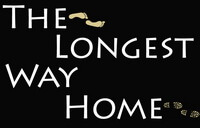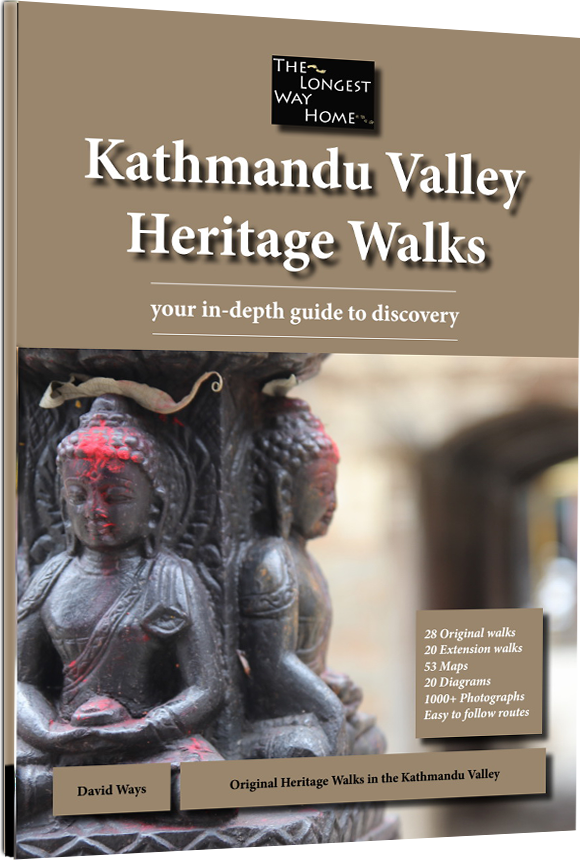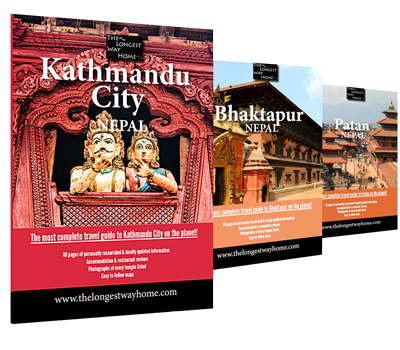About the Kathmandu Valley
The Kathmandu Valley (काठमाडौं उपत्यका) is located in the north-east central region of Nepal. From ancient times to today, it remains an important trading route from Tibet/China to India. The valley itself is the most populous in Nepal with a population of over 2.5 million people which continues to grow at a rate of 4 percent a year.

The capital city of Nepal, Kathmandu city, is located in the Kathmandu valley along with several other cities of historic and cultural importance (including several UNESCO World Heritage sites). These include the old royal capitals of Bhaktapur and Patan.
The Kathmandu Valley is also noted for being the origin point of the Newari people who still populate most of the valley. Due to being a region of commercial value today, there are people of many different cultures and religions living there.
Did you know?
Swayambhunath is said to be the first building ever constructed in the Kathmandu valley. Whereas Kasthamandap is said to be the first building that joined two old Yala towns together which formed Kathmandu city.
For visitors to the Kathmandu Valley, there's a tremendous amount of cultural lineage and physical architecture to be found here that's unlike anywhere else on earth. For full details, I recommend my Kathmandu Valley Heritage Walks Book.
Table of Contents
» Places to see around The Kathmandu Valley
» Getting to The Kathmandu Valley
» History of The Kathmandu Valley
» Preservation of Heritage in The Kathmandu Valley
» Accommodation in The Kathmandu Valley
» Eating out in The Kathmandu Valley
Highlights & places to see in the Kathmandu Valley
While many tourists flock to Nepal for the exquisite mountain views and trekking in Nepal opportunities, the Kathmandu Valley holds its own in terms of stunning architecture, areas of profound cultural significance and places of historic importance for all of Asia. 
Kathmandu city itself holds several areas of intense interest. Thamel is the tourist hotspot with most of the accommodation, restaurants and night spots located there. It's also where all the trekking stores and trekking agents are located. But don't overlook the fantastic heritage walks through the older part of Kathmandu city too.
Other places to visit in the city include Kathmandu's old royal capital Durbar Square. Here you will find such unique buildings like the old royal place, the nine-story temple, the Kumari (living goddess) house and so much more. Take a break to the south of Durbar Square along the infamous hippie hangout known as Freak Street.
Old Kathmandu can be a treasure trove for explorers with Kathmandu heritage walks containing fascinating places like Thahiti Chowk, Ason Chowk, Jana Bahal and Indra Chowk.
On a hill to the west and walkable from the city is Swayambhunath (monkey temple) which is said to be the first building in the valley.
To the west is the Boudhanath which contains the great stupa, the most important location for Buddhists outside of Tibet.
Just to the south of Boudhanath is Pashupatinath which attracts thousands of devotees every year to the Pashupatinath temple. As well as being a revered place for Hindus to be cremated.
A quick 20-minute bus journey to the south and you can visit Kirtipur, one of the rebellious old towns that saw the unification of Nepal.
Equally close by to the north of Kathmandu city is Gokarna where the main temple is surrounded by some of the rarest Hindu and Newari statues in the world.
Just 30 mins outside of the capital within Kathmandu Valley is home to the former capital of Patan. Easily visited on for a day or half-day trip, it's a city filled with art and architecture. From the magnificent Golden Temple to Patan Durbar Square and a chance to visit a Living Goddess there's a lot to see and do here.
Perhaps the Kathmandu Valley's crown jewel is Bhaktapur, a truly beautiful city which is well worth a night or two's stay.  Much less congested than the capital, Bhaktapur contains such amazing sites as the 55-window palace, the Golden Gate, the Nyatapola Temple
(the tallest temple in all Nepal) and so much more.
Much less congested than the capital, Bhaktapur contains such amazing sites as the 55-window palace, the Golden Gate, the Nyatapola Temple
(the tallest temple in all Nepal) and so much more.
Just outside Bhaktapur is the world's tallest Shiva statue Kailashnath Mahadev.
If you are a culture lover then on the way to/from Bhaktapur do stop off at the little visited but charming township of Thimi.
Further out at the edge of the Valley is the fascinating Newari town of Dhulikhel which offers a fantastic blend of day hikes and culture where you can even catch a glimpse of Mount Everest.
If you want to get off the beaten trail then try a simple day trip to the incredibly well preserved Newari township of Panauti.
Finally for those seeking some mountain views and nature there's Nagarkot where on a clear day you can spot a tiny dot (literally) known as Mount Everest.
If you are a fan of heritage, do check out my exclusive book on Kathmandu Valley Heritage Walks.
How to get to the Kathmandu Valley
Internationally there is only way to fly into Nepal and that is via Kathmandu's international airport which is within Kathmandu city in the Kathmandu Valley. Once in Kathmandu city transport to the rest of the Kathmandu valley is easily accessible via road. Either by taxi or bus.
The main destinations within the Kathmandu valley are all within one to one and a half hours drive of each other. The only hic-up is the increased congestion along the main roads. Traveling before peak traffic times is advised.
Kathmandu Valley History
Physical objects indicate that the Kathmandu Valley was inhabited as far back as 300 BC. The earliest inscription is dated as 185 BC (found in Swayambhunath). Various stupas were allegedly constructed around Patan in the 3rd century by the Indian Emperor Ashoka's daughter. However, much like the Buddha's visit, there is no factual proof.
The Kirats are credited to be the first ruling inhabitants of the Kathmandu Valley. Following them in 464 AD was the Licchavi Dynasty. From the 12th century, the Malla's ruled the valley in what was its most popular period until finally in the 18th century, the Shah's took over and formed what is known as Nepal today.
Throughout the history of the Kathmandu Valley, the Newari people have remained at its forefront. They are credited for the unique style of architecture within the valley (multi-roofed pagodas/temples).
For the very best details on Kathmandu Valley's history, do read this book on Kathmandu heritage walks.
Preservation of the Kathmandu Valley
Since 1991, the independently run Kathmandu Valley Preservation Trust (KVPT) has been working to safeguard the architectural heritage of the Kathmandu Valley in Nepal. They have saved more than 50 historic buildings, including temples, step-wells, monasteries, and palaces, and have launched major campaigns for the urban preservation of inhabited buildings throughout the valley. The trust was founded by architectural historian Eduard Sekler. 
Some of the buildings saved include popular attractions such as Mul Chowk, Golden Gate, Indrapur Temple, Kal Bairab, and the Taleju Temple.
Although they work with the Nepalese government, most of the funding comes from overseas donors. The urban preservation projects have been particularly challenging to carry out due to local bureaucracy and privatization.
To learn more about KVPT and see some of the before-and-after photographs, you can visit them at their office in Patan Durbar Square or http://www.kvptnepal.org/
The KVPT are not the only organizations trying to preserve the Kathmandu Valley. Swayambhunath's recent renovation was also privately funded from overseas donations.
In 2015, following the earthquake, the Digital Archaeology Foundation began an ambitious campaign to digitally preserve the remaining temples and monuments in the Kathmandu Valley. Since then, the preservation of Nepal's historical buildings has reached the masses and widespread adoption of their importance.
Impressive 3D scale models of Kathmandu's temples have been produced in an effort to protect them by observing their current state, assisting future restoration work, and independently monitoring and reconstruction attempts.
The biggest fear many historians and architects have for the future of the Kathmandu Valley not only comes from an impending earthquake but also from a lack of funds or private land buyers.
2015 Earthquake
During the April 25th earthquake in Nepal, the Kathmandu Valley suffered significant damage. Kathmandu Durbar Square lost several large temples, as did Patan. However, the vast majority of the buildings are still standing.
Tourism was affected as international media focused on the negative aspects of the earthquake. On the positive side, over 90% of all the hotels in the valley have been reopened after inspection.
Only two major heritage sites reported over 40% damage out of eight. You can see a list of destroyed temples in Nepal. The vast majority survived, as did the valley's infrastructure. The majority of sites are open to tourists today.
In 2024, expect to see Kathmandu Durbar Square still under construction, along with Patan Durbar Square. However, there's still plenty to see within these mainstay attractions, and the vast majority of temples in other areas have been rebuilt. These areas include Bhaktapur and the old city of Kathmandu.
Accommodation in the Kathmandu Valley
Accommodation throughout the Kathmandu Valley ranges from high-end resorts, mid-range hotels and budget guest houses. In recent years a number of boutique Newari theme guest houses have opened in Patan and Bhaktapur. 
While accommodation in the Kathmandu Valley has always been budget friendly in recent years prices have gone up. New high-end hotels now offer better facilities and comfort than the older more dated hotels. Mid-range hotels have faltered slightly with increased prices yet the services have remained the same. Many budget guest-houses have vanished or have been taken over by newer accommodation. Budget guest houses still exist, but they are nowhere near as numerous. Boutique guest houses have appeared in Patan and Bhaktapur with high prices while offering traditional Newari style decor.
Accommodation standards in the Kathmandu Valley vary considerably. If you are looking for international level comfort and facilities then do understand that a 3-star hotel in Nepal can be regarded as one-star elsewhere or rather annoyingly - a genuine three-star. Do read reviews carefully. .
Throughout this website each destination will have it's own accommodation section. More reviews and listings are in my Kathmandu Valley guidebook.
Eating out in the Kathmandu Valley
Eating out around the Kathmandu Valley is easy if you are in popular tourist areas. Once outside of the tourist zones it becomes more challenging to find variety.
Dal Bhat is the most common food in the Kathmandu Valley followed by momos and local specialities. Do choose carefully where you eat as refrigeration and hygiene are not that high when it comes to food in Nepal.
You can see a selection of Nepali dishes here. You can also read my reviews on the best restaurants in Kathmandu.
Transportation & Getting Around the Kathmandu Valley
Getting around the Kathmandu Valley is easier than it first seems.
The number one choice for short trips (under one hour) are taxis, which are not that expensive. If a journey is over one hour and budget is a concern, then the Kathmandu Valley's bus service is fully operational. If taking a taxi, always agree on a price first. Meters are rarely used in Kathmandu.Intercity buses in the Kathmandu Valley generally consist of older buses with conductors on board and no allocated seating.  They operate on a first-come, first-serve basis. Most intercity buses depart from Kathmandu city's Ratna Bus Park. However, in 2023, the bus park was cancelled and turned into offices, so buses are departing from the
area outside and around the area. Generally, each destination will have its own bus area, which all look like an old parking lot.
Or quite literally, the side of the road. In 2015, there was a strong government reform of ticket pricing in the bus services, and there are fewer problems with increased ticket prices now than there was before. My
guidebook to
Nepal is the only one that includes bus prices to all destinations.
They operate on a first-come, first-serve basis. Most intercity buses depart from Kathmandu city's Ratna Bus Park. However, in 2023, the bus park was cancelled and turned into offices, so buses are departing from the
area outside and around the area. Generally, each destination will have its own bus area, which all look like an old parking lot.
Or quite literally, the side of the road. In 2015, there was a strong government reform of ticket pricing in the bus services, and there are fewer problems with increased ticket prices now than there was before. My
guidebook to
Nepal is the only one that includes bus prices to all destinations.
Driving your own car in the Kathmandu Valley is not recommended. The roads are unsealed, and driving standards are poor. There's also little difference in hiring a car or jeep with a driver or without. If you are looking for car hire in Nepal, then feel free to contact me for my recommendation.
Renting a bicycle is good if you plan to go mountain biking around the Kathmandu Valley, but it's not recommended for intercity travel or inner-city travel due to road conditions, pollution, and traffic issues.
Walking is possible in all cities and around the valley. However, do take care, as there are no dedicated walkways, and Nepal operates on a car-first, pedestrian-later mentality.
In 2023, a new hop-on-hop-off bus was launched linking Kathmandu Durbar Square, Boudha, Swayambhu, and Pashupatinath. However, the pricing is two-tier, which has drawn a lot of condemnation. The cost for non-Nepali is 1000 Rps.
For more information on transport, do see this article on getting around Nepal.
Kathmandu Valley Map
The Kathmandu Valley is 1,425 metres (4,675 ft) above sea level. It covers an area of 220 square miles and is surrounded by four mountain ranges.
- You can get a much more detailed map of Kathmandu Valley to download via my guidebook below.
Download my guidebooks to Nepal
Liked this page? You'll love my books! They are hands on guidebooks that are better than the rest. Yes, really! In them I cover all attractions with step-by-step accuracy using well researched information, photographs and travel tested walking tours.
Available in print or digital editions - the best guidebooks for visiting Nepal.
Was this page helpful to you? If so please tell others!




